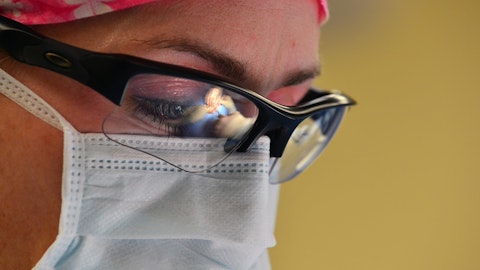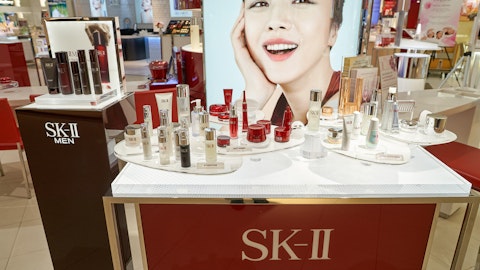This procedure can range from, I don’t know, $2,000 to $5,000, $6,000, $7,000 per procedure. Although it’s done in the doctor clinic and although it’s much cheaper than a full surgical procedures, but yet, it’s expensive, relatively to non-invasive treatment. And we believe from the disposable part of our business, we see some slowdown, not a major slowdown. By the way, in the fourth quarter, we sold more disposable than on the third quarter. But the growth rate was not what we expected. Overall, in 2023, we sold almost 1 million disposable compared to 730,000 in 2022. So we see increase as far as the total numbers of disposable and the total number of our procedure. When I said we see some slowdown, I meant that we don’t see the exact growth rate that we experienced in previous quarter and in previous year.
But that will change, hopefully, when the market will – not the market, when the economy will prosper again and the cost of capital will go down and people will continue to spend money on minimal invasive and plastic surgery as well. So that’s the situation today. And this is the reason why we said we see some slowdown, but don’t take it as a complete slowdown. It’s a slowdown of the rate of growth. Am I explaining myself?
Mike Matson: Yes, that makes sense. Thank you, Moshe.
Operator: Our next question comes from Caitlin Cronin with Canaccord Genuity.
Caitlin Cronin: Hi, everyone. Thanks for taking the questions. I just want to focus on the U.S. for a moment. What was consumable growth in the U.S. in Q4? Was it still – was it positive, was it negative? And then just regarding the guidance for this year, what does that really assume from the U.S. perspective, continued deceleration or some growth?
Yair Malca: Shakil, would you answer that?
Shakil Lakhani: Did you want to go over…
Yair Malca: I can answer the overall consumable growth, did grow around 15%, I would say. Obviously, it’s lower than in the Q1 or Q2 or Q3. So with this – as Moshe mentioned, we do see some slowdown in the growth rate. So it’s in the high teens, but it’s definitely lower than 40% – 40% that we saw in the first half of the year. So in the second half of the year, we start seeing some slowdown in the growth rate.
Caitlin Cronin: Got it. Okay. And then when do you expect the dry eye indication in the U.S. for Envision?
Miri Segal: Say it again? Dry eye indication for…
Moshe Mizrahy: Okay. We are well in the process of finalizing the protocol with the FDA under IDE submission. They ask a few questions. Hopefully, by the end of this month, we will answer them, and they will give us the promotion to do a pivotal study for 510(k) clearance, which will probably start sometime at the end of this quarter. We already selected the sites to do the study according to the protocol that will be approved. It’s a process. But in the meantime, although we do not claim that because we don’t have the clearance yet from the FDA, but we have preliminary study that we did, showing the combination of treatment that’s helping dry eye and doctors are testing it themselves and the results as far as what we hear from the market is great.
Caitlin Cronin: Thank you.
Operator: Thank you. Our next question comes from Jeff Johnson with Baird.
Jeff Johnson: Thank you. Good morning, guys. Moshe, understanding you don’t give quarterly guidance, but I guess I’ll try one more time on it. You have said you don’t expect an improvement in the first half that should come potentially in the second half. If we look back at ’23, obviously, the first half of ’23 was still a very solid year, especially in the first quarter, but both quarters were solid. And you’ve said there’s no improvement in December and January off the kind of second half ’23. So if I put all that kind of in the mix, it would seem to me that it’s just a logical statement to say the first half of the year, probably down mid to upper single digits on a year-over-year basis from a revenue perspective. And then in the second half, the hope would be to get back to kind of mid to upper single-digit growth. If I balance it that way, just is there any flaw in my logic there, even though I know you don’t give quarterly guidance.
Yair Malca: So this is Yair. So we do not give quarterly guidance. But you do see that the overall guidance is pretty much flat year-over-year. I would say that probably the sequence between the quarter, the allocations of this guidance between the quarters will either be similar to 2023 or a little bit back-ended because of all the factors that Moshe mentioned.
Moshe Mizrahy: Yes. I mean, in 2023, the first 2 quarters, the growth compared to 2022 was 20% in the first quarter and the second quarter. If you ask me if we anticipate to have the same growth this year, absolutely not. The second half of 2023 was slow. And the first half of 2023 was with the right momentum. I believe in 2024, it will be the opposite, if I’m right. So the first 2 quarters will be the slowest one and the second 2 quarters, I mean will compensate.
Jeff Johnson: All right. Yes. We’ll try again maybe offline. On the margin side, Moshe, if I look back, pre-COVID your operating margin, and I’m thinking more operating margin. Obviously, your gross margin has stayed very nicely consistent here for many years in the low to mid-80s. If I look at the operating margin, pre-COVID, you were kind of right around that 40% range. Obviously, in the really strong ’21, ’22 years, you picked up to 50%, this past year, kind of 45 guiding to about 44 and 24. So I guess my question is, are we settling in at kind of that low to mid-40s, 44, 45. If I think out over the next 3 to 5 years and if we exclude any kind of M&A, do you think you can hold that low to mid-40s operating margin going forward and kind of grow earnings in line with revenue growth rates? Is that the way to think about kind of the algorithm to end mode over the next several years? Thank you.
Moshe Mizrahy: Absolutely, yes. I mean we’re trying very hard, I mean, to keep the margin steady, gross margin and operating. Although if you notice, we’re spending more money for marketing. And this is because of many reasons. We believe that during a slowdown period, we have to invest more in marketing. I know that many people think differently than me than in a crisis, you need to slow down in expenses. We don’t think the same. We believe that when the market is slowing down or there is some crisis on the market, the opportunity for a company like us is to continue spending R&D, marketing, of course, not G&A, you noticed that and capture market share. Then although, I mean, the total market went down a little bit, but as far as market share, I believe the market share of InMode grow in the last 6 months of the year.
And now we’re waiting to see what Cutera will report. But I’m sure you’ll see that they did not grow this year. On the opposite, they went down. Other companies are – other companies in this industry are mostly private. But here and there, we have some information. Alma [ph] it’s a public company. And as you noticed, they went down in the second half of the year, they did not report the second half, but in the first half of the year, they went down. So for us, keeping the margin is important, but we will not discontinue to invest, not in marketing, not in R&D. We’re not doing cost cutting.
Jeff Johnson: Thank you.
Operator: Thank you. And our final question today comes from Anthony Petrone with Mizuho Financial Group.
Anthony Petrone: Thank you for taking a question. Fit me in here. Maybe one on macro, just as we think about it geographically, how do the pressures in the U.S. stack up relative to Europe and the APAC region. So that would be the first question. And when you think about financing options, Moshe, do we think about, again, directly financing practices? Or will there also be an option for patient finance. And so thinking about an entity in the U.S. such as CareCredit that is providing financing for aesthetic procedures. Can you also step into that market as well? Or again, is this just going to be capital financing? Thanks.
Moshe Mizrahy: Well, good question. As far as territories, I think we mentioned it in the PR, ROW in 2023 growth by something like 18%. North America total was less than that. So – and the reason for that and the reason for that is not because we’re not investing in North America or in the United States. The reason for that is that in 2024 – in 2023, we have established 2 new subsidiaries, one in Japan and one in Germany, Austria, and we continue to hire more people and more salespeople because the ROW market is important for us. And we believe that ROW will grow in 2024. We have a plan to continue to invest in addition to what we’re investing in the United States. So ROW in 2023 grow a little bit more than in the U.S., especially in platforms and new territories and new, I would say, regulatory clearances that we received for different countries.
As far as financing customers, we’ve never been in this business, there are companies that are doing it and they work directly with the doctors. We don’t intend to go to finance customers because this is not the business that we’re in. We will help to using our strong balance sheet, as Yair said and I said to help the leasing company or share the risk with them to expedite the process of clearing transaction for the doctors. But as far as customers, we do not intend to get into this business.
Operator: Thank you. We’ve run out of time for questions today. This concludes our question-and-answer session. I would like to turn the conference back over to Moshe Mizrahy, Chairman and CEO, for any closing remarks.
Moshe Mizrahy: Thank you, operator. Again, I would like to say that although 2023 was a challenging year for us, but we keep the momentum. And we know how to turn slowdown and crisis into opportunities. And I believe we did that with all the new R&D, the new 2 subsidiaries that we build even in a tough time, adding more people all over the world in order to enlarge the sales force and the support force. I would like to thank all InMode employees worldwide for the hard work they gave in 2023. Especially, I would like to thank the Israeli team. As everybody knows, we are facing a very challenging time in Israel. And I think that the effort that people in Israel did since October when the world started to make sure that we will run the business as usual, although many of the team in the manufacturing and in the office, when on reserve duty, everybody work over time as much as needed.
We rescheduled the manufacturing line to make sure that we will be able to supply everything to everybody within 7 days, and we did it very well, and we continue to support and we continue to look for the cost, maintaining the margin. I hope 2024 will be a better year for us. Although 2023 was not – I don’t want to say that it was a tough year, but not a bad year. So thank you all and looking forward to see you at the end of the first quarter.
Operator: The conference has concluded. Thank you for attending today’s presentation. You may disconnect.





